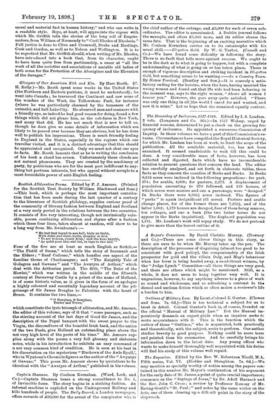Scottish Alliterative Poems. Edited by F. J. Amours. (Printed for
the Scottish Text Society by William Blackwood and Sons.) —This book, which is perhaps the most important contribu- tion that has been made during the last quarter of a century to the literature of Scottish philology, supplies curious proof of the community of literary fashion between England and Scotland at a very early period in the relations between the two countries. It consists of five very interesting, though not intrinsically valu- able, poems combining alliteration and rhyme after a fashion which these four lines, taken almost at random, will show to be a long way from Mr. Swinburne's :— "Be had that heynd to ane ball, biely on bight. With dnkis and digne lordis, doughty in deal. 'Ye are welconi, enmly King,' said the kene knyght, ' Ay (IOU your likis and list, to Inge in this laid.'"
Four of the five are at least as much English as Scotch,— " The Pistil of Susan," which tells the story of Susannah and the Elders ; " Rauf Coilzear," which handles one aspect of the familiar theme of Charlemagne ; and "The Knightly Tale of
olagros and Gawane " and "The Awntyrs of Arthur," which deal with the Arthurian period. The fifth, "The Buke of the Howlat," which was written in the middle of the fifteenth century at Darnaway Castle by a priest of the name of Holland, is of some historic value, as it gives in the form of an apologue a highly coloured and essentially legendary account of the pil- grimage of Sir James Douglas to Palestine with the heart of Bruce. It contains the two lines,— " 0 Dowglass, 0 Dowglass, Tender and Trewe,"
which constitute the lyric triumph of alliteration, and Mr. Amours, the editor of this volume, says of it that "some passages, such as the stirring account of the last days of Good Sir James, and the description of the Papal banquet with the sweet prayer to the Virgin, the discomfiture of the boastful Irish bard, and the antics of the two Fools, give Holland an outstanding place above the not very high level of the poets of his time." Mr. Amours sup- plies along with the poems a very full glossary and elaborate notes, while in his introduction he exhibits an easy command of a not very common kind of erudition. He is seen at his best in his dissertation on the mysterious " Huchown of the Awle Ryan:, who in Wyntoun's Chronicle figures as the author of the " Awyntyr of Gawane." This poem Mr. Amours shows by quotations to be identical with the "Awntyra of Arthur," published in his volume.


































 Previous page
Previous page